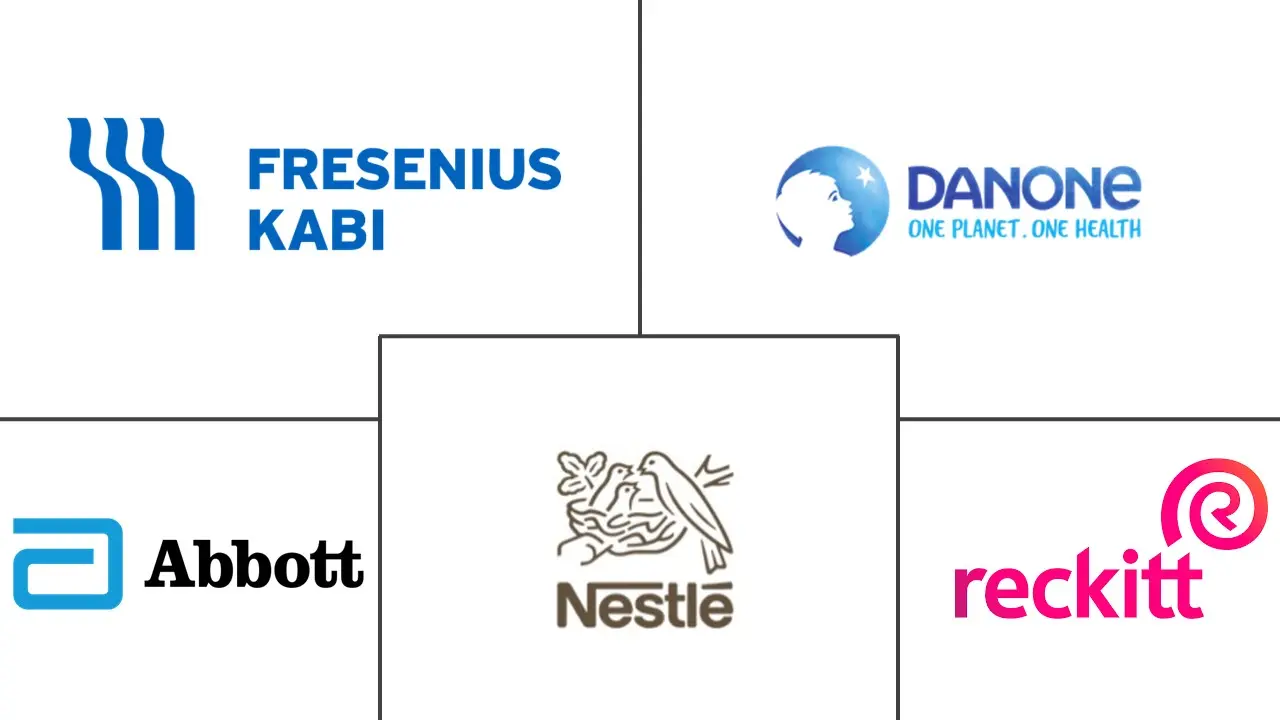Enteral Feeding Formulas Market Size and Share
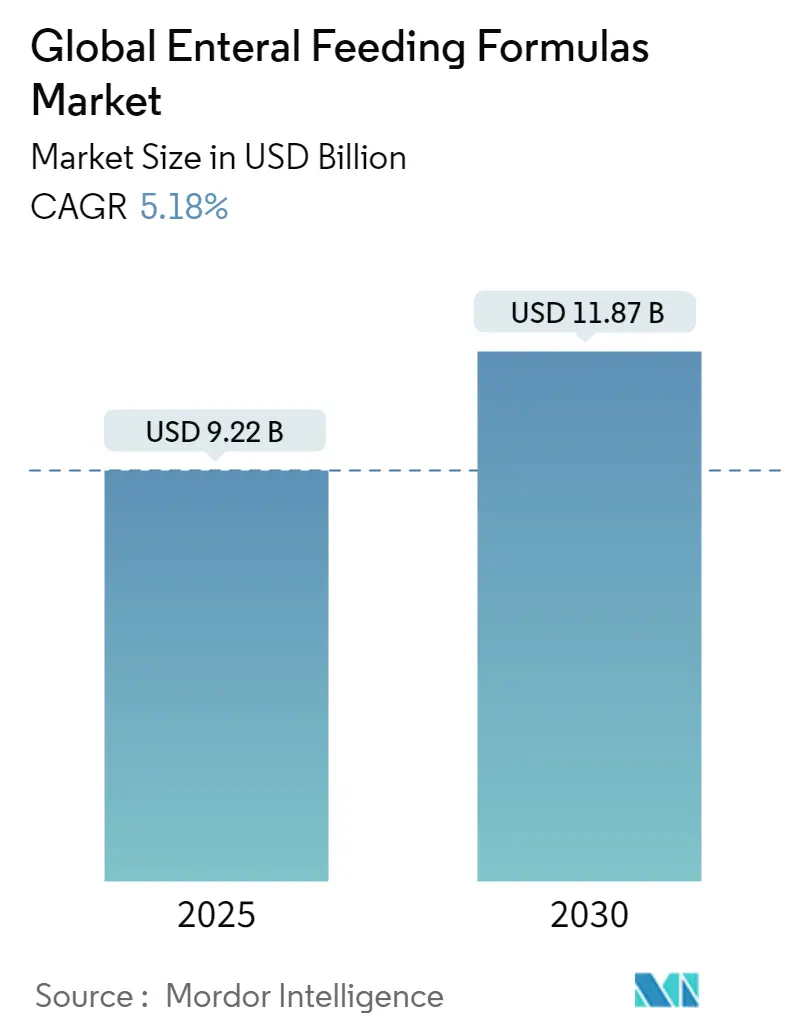
Enteral Feeding Formulas Market Analysis by Mordor Intelligence
The enteral feeding formulas market size stands at USD 9.22 billion in 2025 and is forecast to reach USD 11.87 billion by 2030, reflecting a 5.18% CAGR over the period. Momentum arises from demographic aging, rising chronic disease incidence, and accumulating clinical evidence that tube feeding shortens hospital stays and lowers infection risk versus parenteral options. Technology-enabled pumps, clean-label formulas, and AI-driven nutrient titration broaden clinical acceptance, while capacity expansions by Abbott and Danone underscore sustained demand. Although supply-chain fragilities in amino acids persist, strategic sourcing initiatives and near-shoring temper price volatility. The enteral feeding formulas market increasingly functions as a core component of chronic-care infrastructure rather than a niche adjunct therapy.
Key Report Takeaways
- By product type, standard polymeric formulas led with 54.31% revenue share in 2024, while blenderized real-food formulas are projected to expand at a 6.15% CAGR through 2030.
- By caloric density, isocaloric formulas accounted for 45.89% of the enteral feeding formulas market share in 2024 and hypercaloric formulas are advancing at a 5.89% CAGR to 2030.
- By end user, hospitals and acute-care centers held 62.15% share of the enteral feeding formulas market size in 2024, whereas homecare is growing fastest at 6.93% CAGR through 2030.
- By age group, adults represented 53.82% share in 2024, yet pediatrics is forecast to record the highest 5.67% CAGR to 2030.
- By geography, North America commanded 42.23% revenue share in 2024, while Asia-Pacific is poised for a 6.19% CAGR through 2030.
Global Enteral Feeding Formulas Market Trends and Insights
Driver Impact Analysis
| Driver | (~) % Impact on CAGR Forecast | Geographic Relevance | Impact Timeline |
|---|---|---|---|
| Aging population & surge in chronic diseases | +1.8% | Global, with concentration in North America & Europe | Long term (≥ 4 years) |
| Shift from parenteral to enteral nutrition in acute-care settings | +1.2% | Global, led by North America & EU | Medium term (2-4 years) |
| Rapid uptake of home-enteral pumps & accessories | +0.9% | APAC core, spill-over to North America | Short term (≤ 2 years) |
| Clean-label real-food formulas boosting patient adherence | +0.7% | North America & EU, expanding to APAC | Medium term (2-4 years) |
| E-prescription-linked AI tools enabling personalized macronutrient titration | +0.5% | North America, early adoption in EU | Long term (≥ 4 years) |
| Source: Mordor Intelligence | |||
Aging Population & Surge in Chronic Diseases
One in six people globally will be over 65 by 2050, driving sustained demand for specialized tube-feeding solutions. Abbott’s Ensure surpassed USD 3 billion sales in 2024, illustrating how older adults prioritize nutritional maintenance. Intensifying diabetes, cardiovascular, and gastrointestinal conditions further enlarge the enteral feeding formulas market as oral intake declines. Randomized studies show early enteral nutrition lowers mortality and shortens hospital stays, prompting payers to treat feeding tubes as preventive care. Health-system protocols now mandate enteral initiation within 48 hours of ICU admission, cementing its role as first-line therapy rather than secondary support.
Shift from Parenteral to Enteral Nutrition in Acute-Care Settings
Meta-analysis confirms a 27% reduction in bloodstream infections when hospitals substitute parenteral with enteral feeding. Cost-benefit studies in esophageal cancer indicate USD 57,000 lower mean episode costs for enteral routes. Professional bodies such as ASPEN recommend enteral delivery within 48 hours of critical illness, standardizing adoption. Smart pumps with remote alarms mitigate administration risk, while bedside algorithms match caloric targets in real time. Combined, these clinical, economic, and technological forces accelerate displacement of parenteral modalities.
Rapid Uptake of Home-Enteral Pumps & Accessories
Home health outlays are rising 6-8% annually, building a supportive payment environment for at-home tube feeding. Kangaroo Connect pumps offer 24-hour batteries and cloud telemetry that caregivers manage via smartphones. U.S. Medicare eased paperwork for enteral claims in 2025, accelerating discharges to community settings. Families value quality-of-life gains as portable pumps reduce tethering to hospital beds. These dynamics push the enteral feeding formulas market toward decentralized, patient-centric delivery models.
Clean-Label Real-Food Formulas Boosting Patient Adherence
Plant-based innovators such as Kate Farms achieve 40% repeat-purchase rates with organic, blenderized SKUs. Clinical pilots report fewer episodes of constipation and improved GI tolerance versus synthetic mixesnew. Danone’s EUR 70 million investment in France and May 2025 acquisition of Kate Farms signal mainstream acceptance. FDA’s 2025 “healthy” label rule validates consumer preference for recognizable ingredients[1]Source: "Nestlé Health Science Signs Agreement to Acquire Global Rights to VOWST®," nestlehealthscience.com . Collectively, natural formulations open new adoption pathways beyond hospitals into wellness-oriented channels.
Restraint Impact Analysis
| Restraint | (~) % Impact on CAGR Forecast | Geographic Relevance | Impact Timeline |
|---|---|---|---|
| GI-related complications & aspiration risk perceptions | -0.8% | Global, particularly in emerging markets | Short term (≤ 2 years) |
| Fragmented reimbursement for disease-specific formulas | -0.6% | North America & EU, varying by country | Medium term (2-4 years) |
| Concentrated supply chain for specialty amino-acid blends | -0.4% | Global, with acute impact in APAC | Short term (≤ 2 years) |
| High viscosity of plant-based blends causing pump occlusion issues | -0.3% | North America & EU, early adopter markets | Medium term (2-4 years) |
| Source: Mordor Intelligence | |||
GI-Related Complications & Aspiration Risk Perceptions
Systematic reviews identify nausea, vomiting, and aspiration pneumonia as deterrents to timely tube-feeding initiation, particularly in frail elders. Limited access to post-pyloric placement skills in community hospitals elevates hesitation, while only 28.5% of Ethiopian nurses demonstrated competent enteral techniques in 2024 audits. Although new formulations with fiber and anti-reflux properties mitigate intolerance, perception lags, restraining immediate acceleration in some regions.
Fragmented Reimbursement for Disease-Specific Formulas
Coverage varies widely: U.S. payers reimburse renal formulas but often deny neuro-degenerative indications, and EU nations apply divergent cost-effectiveness thresholds. Prior authorizations add administrative load that discourages prescription of premium SKUs. While 2025 CMS rule changes eased documentation, uncertainty remains for rare-disease products, tempering R&D investments.
Segment Analysis
By Product Type: Real-Food Innovation Disrupts Traditional Formulas
Standard polymeric blends retained leadership, accounting for 54.31% of the enteral feeding formulas market share in 2024, largely due to broad clinical familiarity and lower unit costs. Emerging blenderized real-food offerings captured caregiver interest and are forecast for 6.15% CAGR, propelled by plant-based branding and demonstrated GI benefits.
In response, incumbents incorporate organic pea protein and non-GMO oils into legacy lines, while high-protein and peptide-based variants defend niches where malabsorption or wound healing require elevated amino acid density. Elemental formulas remain essential for severe GI compromise yet face palatability and cost barriers, limiting widespread diffusion. Disease-specific products addressing diabetes or renal impairment align with precision-nutrition trends, signaling future premiumization of the enteral feeding formulas market.

Note: Segment shares of all individual segments available upon report purchase
By Caloric Density: Hypercaloric Growth Meets Specialized Needs
Isocaloric (≈ 1 kcal/ml) products secured 45.89% share of the enteral feeding formulas market size in 2024 because they satisfy most standard feeding prescriptions. Hypercaloric (1.2–1.5 kcal/ml) lines will expand 5.89% CAGR, driven by fluid-restricted cardiac and renal patients requiring compact nutrient delivery.
Formulation advances allow higher caloric density without excessive viscosity, improving pump compatibility and patient comfort. Very-high-calorie products (≥ 2 kcal/ml) answer severe malnutrition but remain niche due to tolerance issues, whereas low-energy blends meet pediatric and bariatric protocols. Intensifying homecare favors concentrated formats that minimize bag changes and enhance mobility, reinforcing hypercaloric momentum within the enteral feeding formulas market.
By End-User: Homecare Acceleration Transforms Care Delivery
Hospitals and acute-care facilities commanded 62.15% share in 2024 given guideline-driven inpatient initiation. Nevertheless, homecare channels will post a 6.93% CAGR as payers incentivize early discharge and remote monitoring technology matures.
Portable pumps equipped with Bluetooth telemetry enable clinicians to adjust regimens virtually, reducing readmissions and overall cost of care. Long-term care institutions maintain steady demand tied to aging cohorts, while outpatient infusion centers leverage bundled reimbursement to integrate nutrition management. Collectively, these shifts decentralize delivery and enlarge the total addressable enteral feeding formulas market.
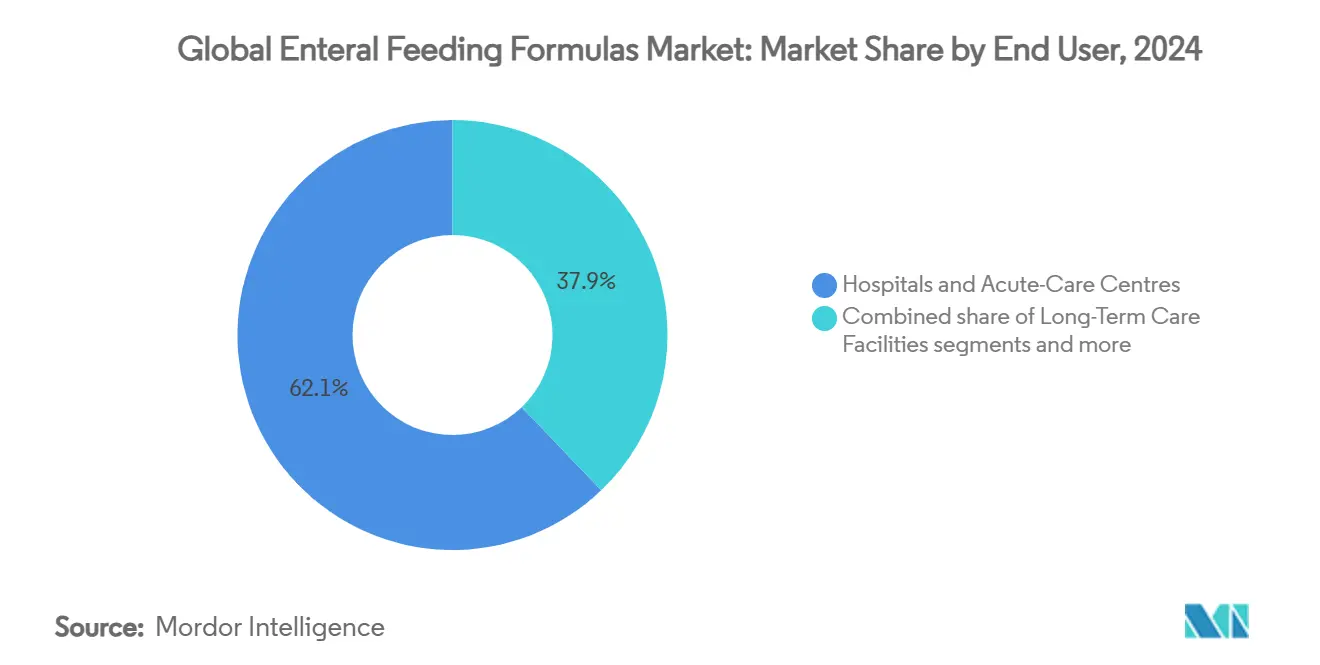
Note: Segment shares of all individual segments available upon report purchase
By Age Group: Pediatric Specialization Drives Innovation
Adults held 53.82% of revenue in 2024, reflecting the prevalence of chronic diseases requiring tube feeding. The pediatric cohort, however, is projected for the fastest 5.67% CAGR as specialized peptide-based formulas enhance tolerance in cerebral palsy and metabolic disorders.
Neonatal SKUs employ hydrolyzed proteins and MCT oils to match immature GI function, commanding premium pricing. Regulatory clarity from FDA and EMA on infant-formula disruptions streamlines approvals, encouraging innovation. Meanwhile, geriatric-specific blends with added HMB and vitamin D gain traction as muscle-maintenance tools, reinforcing age-tailored sub-segments of the enteral feeding formulas market.
Geography Analysis
North America contributed 42.23% of global revenue in 2024 due to sophisticated reimbursement systems, high ICU penetration of tube feeding, and rapid uptake of AI-driven pumps. U.S. Medicare’s simplified billing codes and Canada’s single-payer coverage sustain volume, while Mexico’s growing middle class begins demanding premium formulas. Regional manufacturing, exemplified by Abbott’s USD 92 million Gujarat facility serving U.S. export as well as Indian domestic demand, bolsters supply resilience.
Europe shows steady uptake under harmonized ESPEN guidelines, yet fragmentation in reimbursement creates variable country growth. Germany emphasizes immune-enhancing blends, the United Kingdom invests in mental-performance nutrition, and Italy’s high per-capita supplement spend fosters premium tube-feeding adoption. Spain, conversely, values palatability aligned with culinary culture, spurring R&D on flavor masking.
Asia-Pacific is the fastest-growing arena, projected at 6.19% CAGR through 2030 as China, India, and Southeast Asia modernize ICUs and embrace homecare. Synutra’s pivot from infant formula to adult meal replacements in China illustrates category stretch. Joint ventures, such as Nestlé-Dr. Reddy’s in India, leverage local distribution for specialized products. South America and the Middle East & Africa remain emerging, with Brazil’s USD 209 billion food-processing sector and GCC healthcare investments hinting at long-term opportunity.
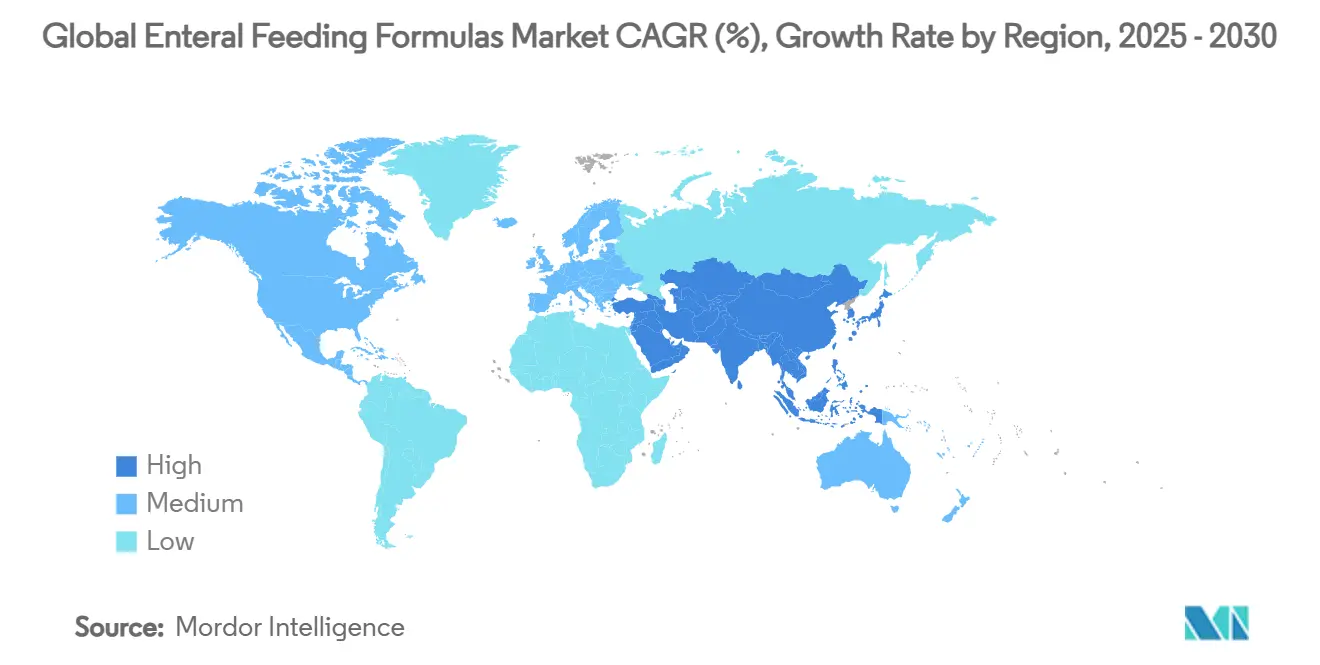
Competitive Landscape
Market concentration is moderate: Abbott, Nestlé, Danone, and Fresenius together capture a sizable but not dominant portion, while regional specialists and plant-based entrants fragment share. Danone’s 2025 acquisition of Kate Farms brings clean-label capability under a multinational umbrella, expanding reach to 1,400 U.S. hospitals. Nestlé Health Science’s deal for microbiota-based VOWST underscores diversification into gut-health therapeutics[2]Source: Federal Register, “Food Labeling: Nutrient Content Claims; Definition of Term ‘Healthy’,” Federal Register, federalregister.gov .
Manufacturing investments endorse volume growth: Abbott’s Gujarat site sources 80% local inputs, mitigating currency risk, and Danone’s EUR 70 million French line focuses on medical formulations. Supply-chain robustness becomes a differentiator; Fresenius won the 2024 Trailblazer Award for logistics excellence amid amino acid shortages. Meanwhile, software-plus-hardware ecosystems emerge, integrating pumps, AI algorithms, and tele-nutrition services, raising switching costs and reinforcing recurring revenue within the enteral feeding formulas market.
White-space opportunities persist. Personalized nutrition platforms coupling genetic tests to formula adjustments remain nascent. Rare-disease formulas encounter reimbursement barriers yet offer high margins. Start-ups explore 3-D-printed dysphagia-friendly textures, while pharma collaborations (e.g., OPKO Health and Entera Bio’s dual-agonist obesity pill) may indirectly influence feeding volumes.
Enteral Feeding Formulas Industry Leaders
-
Abbott Laboratories
-
Nestle SA
-
Reckitt Benckiser Group plc. (Mead Johnson)
-
Danone SA (Nutricia)
-
Fresenius SE & Co. KgaA (Fresenius Kabi AG)
- *Disclaimer: Major Players sorted in no particular order
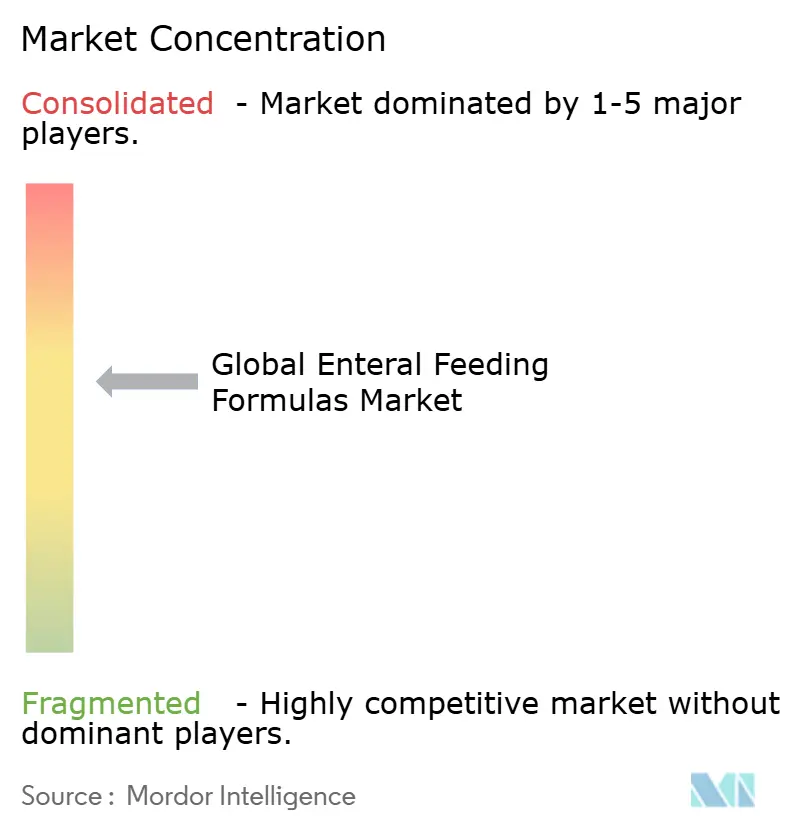
Recent Industry Developments
- May 2025: Danone acquired Kate Farms, expanding its organic tube-feeding portfolio
- November 2024: Fresenius Kabi received the 2024 Novaplus Program Excellence Award from Vizient.
Global Enteral Feeding Formulas Market Report Scope
As per the scope of the report, enteral feeding refers to the delivery of a nutritionally complete feed containing protein, carbohydrates, fat, water, minerals, and vitamins directly into the stomach, duodenum, or jejunum. The report is segmented by Product (Standard Formulas and Disease-specific Formulas), Application (Oncology, Neurology, Critical Care, Diabetes, Gastroenterology, and Others), End-User (Hospitals, Home Care Agencies, and Hospices, and Other End User), Distribution Channel (Hospitals, Retail Pharmacies, and Online Pharmacies), and Geography (North America, Europe, Asia-Pacific, Middle East and Africa, and South America). The market report also covers the estimated market sizes and trends for 17 different countries across major regions globally. The report offers the value (in USD million) for the above segments.
| Standard Polymeric Formulas | |
| High-Protein Polymeric Formulas | |
| Peptide-Based / Semi-Elemental Formulas | |
| Elemental (Amino-Acid) Formulas | |
| Disease-Specific Formulas | Diabetes-Specific |
| Renal-Specific | |
| Hepatic Support | |
| Oncology / Immunonutrition | |
| Pulmonary (COPD) | |
| GI & Malabsorption (IBD, SBS) | |
| Immune-Modulating / Synbiotic Formulas | |
| Blenderized Real-Food Formulas |
| Low Energy (<1.0 kcal/ml) |
| Isocaloric (≈1.0 kcal/ml) |
| Hypercaloric (1.2 – 1.5 kcal/ml) |
| Very-High Calorie (≥2.0 kcal/ml) |
| Hospitals & Acute-Care Centres |
| Long-Term Care Facilities |
| Home Enteral Nutrition (HEN) |
| Out-patient / Ambulatory Clinics |
| Neonates (0–28 days) |
| Pediatrics (1 month–17 yrs) |
| Adults (18–64 yrs) |
| Geriatrics (≥65 yrs) |
| North America | United States |
| Canada | |
| Mexico | |
| Europe | Germany |
| United Kingdom | |
| France | |
| Italy | |
| Spain | |
| Rest of Europe | |
| Asia-Pacific | China |
| India | |
| Japan | |
| South Korea | |
| Australia | |
| Rest of Asia-Pacific | |
| South America | Brazil |
| Argentina | |
| Rest of South America | |
| Middle East and Africa | GCC |
| South Africa | |
| Rest of Middle East and Africa |
| By Product Type (Value) | Standard Polymeric Formulas | |
| High-Protein Polymeric Formulas | ||
| Peptide-Based / Semi-Elemental Formulas | ||
| Elemental (Amino-Acid) Formulas | ||
| Disease-Specific Formulas | Diabetes-Specific | |
| Renal-Specific | ||
| Hepatic Support | ||
| Oncology / Immunonutrition | ||
| Pulmonary (COPD) | ||
| GI & Malabsorption (IBD, SBS) | ||
| Immune-Modulating / Synbiotic Formulas | ||
| Blenderized Real-Food Formulas | ||
| By Caloric Density (Value) | Low Energy (<1.0 kcal/ml) | |
| Isocaloric (≈1.0 kcal/ml) | ||
| Hypercaloric (1.2 – 1.5 kcal/ml) | ||
| Very-High Calorie (≥2.0 kcal/ml) | ||
| By End-user (Value) | Hospitals & Acute-Care Centres | |
| Long-Term Care Facilities | ||
| Home Enteral Nutrition (HEN) | ||
| Out-patient / Ambulatory Clinics | ||
| By Age Group (Value) | Neonates (0–28 days) | |
| Pediatrics (1 month–17 yrs) | ||
| Adults (18–64 yrs) | ||
| Geriatrics (≥65 yrs) | ||
| By Geography (Value) | North America | United States |
| Canada | ||
| Mexico | ||
| Europe | Germany | |
| United Kingdom | ||
| France | ||
| Italy | ||
| Spain | ||
| Rest of Europe | ||
| Asia-Pacific | China | |
| India | ||
| Japan | ||
| South Korea | ||
| Australia | ||
| Rest of Asia-Pacific | ||
| South America | Brazil | |
| Argentina | ||
| Rest of South America | ||
| Middle East and Africa | GCC | |
| South Africa | ||
| Rest of Middle East and Africa | ||
Key Questions Answered in the Report
What is the current value of the enteral feeding formulas market?
The market is valued at USD 9.22 billion in 2025.
How fast is the sector expected to grow?
It is projected to register a 5.18% CAGR and reach USD 11.87 billion by 2030.
Which region is expanding the quickest?
Asia-Pacific shows the fastest trajectory, forecast at 6.19% CAGR through 2030.
Which product segment is growing the most rapidly?
Blenderized real-food formulas are advancing at a 6.15% CAGR, outpacing traditional blends.
How significant is homecare within tube feeding?
Homecare, boosted by smart pumps and favorable reimbursement, is expected to grow 6.93% annually through 2030.
What major acquisition shaped the competitive field in 2025?
Danone's acquisition of Kate Farms broadened its plant-based medical nutrition portfolio.
Page last updated on:
